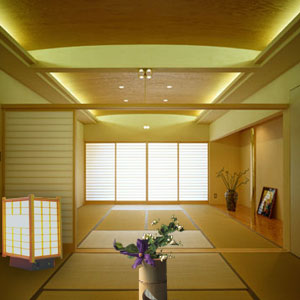Japanese Décor

You can do your den or even your living room or bedroom in typical Japanese style. Use of neutral and natural colors is intrinsic to Japanese décor. Interiors done up in Japanese style offer an uncluttered feeling, one that epitomize simplicity and clean lines. Japanese décor seeks harmony with the natural environment. One of the key elements is to bring nature indoors. The emphasis is not on bold vibrant flower arrangements but more on simple green plants. Minimalist décor is the key theme!
Principles of Japanese decor
- Use of geometric order, definition and form is an integral part of Japanese décor.
- The yin and yang must be well balanced. Be it in the balance of polished floors and textured mats or black lacquered boxes and smooth white pebbles, Japanese décor lends a curiously calm balance to interiors.
- Japanese lanterns usually have round or boxy shapes and made with silk or rice paper.
- Curtains at windows are not fussy or fancy but are instead simple panels or sheer and light.
- Use goza mats on tables, benches or on the floor. Tatami rugs and goza rugs make for attractive accessories at the verandah, kitchen or entryway.
- Large expansive windows that allow the light to stream in are preferred.
- Hibachis or decorative fireplaces made in either ceramic, lacquer, rattan or metal can be used as bases for end tables or even flower holders.
Japanese décor
Japanese décor is influenced by lack of space and permanency of the houses - Light weight furniture, glass walls that slide and change the room, beds that are pulled out from cupboards and stackable pieces of furniture. Elements of Japanese décor include tatami floor mats, textured silk, rice paper lanterns and shoji screens.
Shoji screens serve to divide spaces into separate forms and functions. Decorated in vibrant colors and symbols, such screens are intrinsic to Japanese homes and spaces. Shoji screens are often made from kiln dried hardwood and unique rice paper blend. This makes them opaque yet allowing for diffused light to seep through. Shoji screens make best use of limited space. They are an alternative to swinging doors that take more space. Most often in modern homes, these Japanese screens come as glass panels within a wooden grid. In fact the wooden texture is reflected everywhere; be it bamboo flooring or wooden shelves. The wooden element is incorporated in the color scheme as well. A soothing and calm room inspired by Japanese décor style or Zen style is sure to lend tranquility.
Folding Screens come in different sizes based on their intended use. These screens were used during tea ceremonies, concerts and Buddhist rites.
Tatami Mats are woven straw mats that were initially seen as a sign of wealth. They are laid on the floor and usually never stepped open with footwear.
Low Tables and large flat cushions or Zabuton are intrinsic Japanese décor elements. Other aspects of Japanese home design are alcoves or Tokonoma and traditional ceilings or Tenjo.
Folding screens with beautiful artwork representing elements of nature and motifs are used as room separators or partitions. Internal walls are often done away with and the entire space is then seamlessly allowed to flow through.
Top of the Page: Japanese Décor
Tags:#Japanese décor
 Home and Garden
Home and Garden Apartment Decor
Color Decorating Schemes
Loft Decor
Decorating Small Space
Floor Decor
Halloween Decoration
Driftwood Home Accents
Wood Paneling
Artificial Christmas Tree
Christmas Ornament
Steel entry door
Home Improvement Catalog
Interior Decorating Idea
Sunroom Designs
Master Bedroom Ideas
Kid Room Décor
Country Home Décor
Lodge Décor
Beach House Decorating
Laundry Room Decor
Moroccan Decor
Japanese Décor
Living Room Makeover
Nautical Home Décor
Home Improvement Tips
Do it yourself Home Improvement
Kitchen Remodeling Idea
Home Improvement Contractor
Home Garden Design
Lower Energy Bills
Laminate flooring
...
Thanksgiving Decoration
Furnitures
 Home Furnishing Idea
Home Furnishing Idea Sectional Sofas
Leather Sofa
Furniture Arrangement
Hammock
Armoire
Dresser
Home Bar
Door Knocker
Footstool
Wood Bookcase
Rice Paper Blinds
Table Decoration
Christmas Centerpiece
Rattan Furniture
Top of the Page: Japanese Décor
Popularity Index: 100,800

